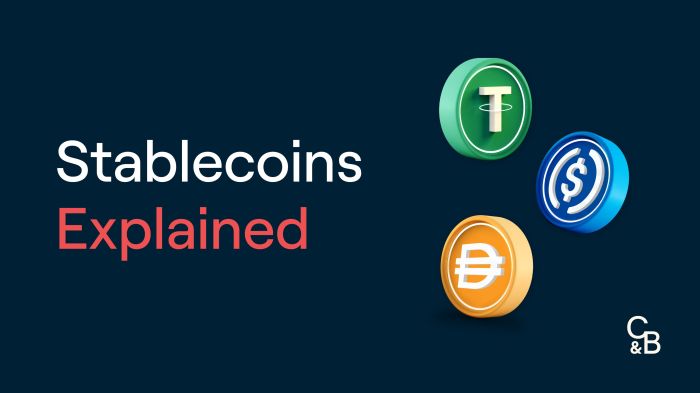Stablecoins explained – diving into the world of digital currencies that bring stability to the volatile crypto market. From Tether to USD Coin, get ready to unravel the secrets behind these game-changers.
Are you ready to explore the dynamic landscape of stablecoins and their impact on the financial world? Let’s break it down and discover how these coins are reshaping the future of finance.
Introduction to Stablecoins

Stablecoins are a type of cryptocurrency designed to minimize the volatility that is common in traditional cryptocurrencies like Bitcoin and Ethereum. They are pegged to a stable asset, such as fiat currency like the US dollar or commodities like gold, to maintain a consistent value.
Purpose of Stablecoins in the Crypto Market
Stablecoins serve as a bridge between the traditional financial world and the crypto space by providing a stable medium of exchange and store of value. They offer a less volatile alternative for traders and investors to park their funds during market downturns or when seeking to avoid the high price fluctuations of other cryptocurrencies.
Popular Stablecoins Examples
- Tether (USDT): Tether is one of the most widely used stablecoins and is pegged 1:1 to the US dollar.
- USD Coin (USDC): USD Coin is another popular stablecoin pegged to the US dollar and is regulated by financial authorities.
- DAI: DAI is a decentralized stablecoin that is pegged to the US dollar through an algorithmic system without relying on a central authority.
Types of Stablecoins

Stablecoins come in various types, each with its own set of mechanisms and characteristics that determine their stability and value in the market.
Fiat-Collateralized Stablecoins
Fiat-collateralized stablecoins are backed by traditional fiat currencies like the US dollar or Euro. Each stablecoin issued is backed by an equivalent amount of fiat currency held in reserve. This type offers stability as it is pegged to a stable asset, but it relies heavily on trust in the custodian holding the reserves. Examples include Tether (USDT) and USD Coin (USDC).
Crypto-Collateralized Stablecoins
Crypto-collateralized stablecoins are backed by other cryptocurrencies held in reserve. These stablecoins are over-collateralized to maintain their stability, with smart contracts ensuring the appropriate ratio of collateral to stablecoin issuance. While this type offers decentralization, it can be volatile due to fluctuations in the underlying collateral. Examples include Dai and sUSD.
Algorithmic Stablecoins
Algorithmic stablecoins use complex algorithms to adjust the supply of stablecoins in circulation based on demand. These stablecoins do not have any collateral backing and rely on the algorithm to maintain stability. While they offer decentralization and independence from traditional assets, they can be susceptible to manipulation and require a high level of trust in the algorithm. Examples include Ampleforth and Terra.
Hybrid Stablecoins, Stablecoins explained
Hybrid stablecoins combine elements of both fiat-collateralized and algorithmic stablecoins. They have a collateral reserve of both fiat currencies and cryptocurrencies, while also utilizing algorithms to maintain price stability. This type aims to leverage the benefits of both models while mitigating their respective drawbacks. Examples include Reserve and Synthetix.
Use Cases of Stablecoins: Stablecoins Explained
Stablecoins have become an essential component of the financial sector, offering a wide range of use cases that benefit businesses and individuals alike. These digital assets are designed to maintain a stable value, making them ideal for various applications in the crypto market.
Remittances
Stablecoins are increasingly being used for cross-border remittances due to their low transaction fees and fast settlement times. Companies like BitPesa and Stellar are leveraging stablecoins to facilitate seamless and cost-effective money transfers, especially in regions with limited access to traditional banking services.
Trading
Stablecoins play a crucial role in crypto trading by providing a stable store of value for investors to hedge against market volatility. Platforms like Binance and Coinbase offer a wide range of stablecoin trading pairs, allowing users to trade cryptocurrencies without the risk of price fluctuations.
Lending
Stablecoins are also used for lending purposes, enabling users to earn interest on their digital assets. Platforms like Compound and Aave allow users to borrow and lend stablecoins, providing liquidity to the market while earning passive income on their holdings.
Decentralized Finance (DeFi)
Stablecoins are the backbone of the rapidly growing DeFi ecosystem, powering various decentralized applications like decentralized exchanges (DEXs), lending protocols, and yield farming platforms. Projects like MakerDAO and Uniswap rely on stablecoins to enable seamless and efficient financial transactions without the need for traditional intermediaries.
By reducing volatility and increasing liquidity in the crypto market, stablecoins have revolutionized the way we transact and invest in digital assets, paving the way for a more inclusive and accessible financial system.
Regulation and Challenges
In the world of stablecoins, navigating the regulatory landscape is crucial for ensuring compliance and legitimacy. Let’s dive into the various regulations and challenges that stablecoin projects face.
Regulatory Landscape
- United States: In the US, stablecoins are subject to regulations by various agencies such as the SEC, CFTC, and FinCEN. Depending on their structure and use case, stablecoins may be classified as securities, commodities, or money transmitters.
- European Union: The EU has introduced the Markets in Crypto-Assets Regulation (MiCA) to regulate stablecoins and other crypto-assets. This framework aims to provide clarity and consumer protection in the digital asset space.
- Asia-Pacific: Countries in this region have varying approaches to regulating stablecoins, with some embracing innovation while others imposing strict restrictions to protect financial stability.
Challenges and Risks
- Regulatory Scrutiny: Stablecoin projects face intense scrutiny from regulators due to concerns related to money laundering, consumer protection, and financial stability. Compliance with ever-changing regulations poses a significant challenge.
- Centralization: Some stablecoins are criticized for being too centralized, raising concerns about censorship, control, and counterparty risk. Achieving decentralization while maintaining stability is a delicate balance.
- Security Concerns: The security of stablecoin reserves, smart contracts, and the overall infrastructure is a major risk. Hacks, bugs, or vulnerabilities could lead to loss of funds and erode trust in the stablecoin ecosystem.
Addressing Challenges
- Transparency: Stablecoin projects can enhance trust by providing regular audits, disclosures of reserve assets, and transparent governance mechanisms to ensure accountability.
- Decentralization: Implementing decentralized governance, multi-sig wallets, and open-source protocols can reduce centralization risks and enhance the resilience of stablecoin systems.
- Security Measures: Investing in rigorous security audits, bug bounties, and robust smart contract development practices can help mitigate security risks and protect user funds.
